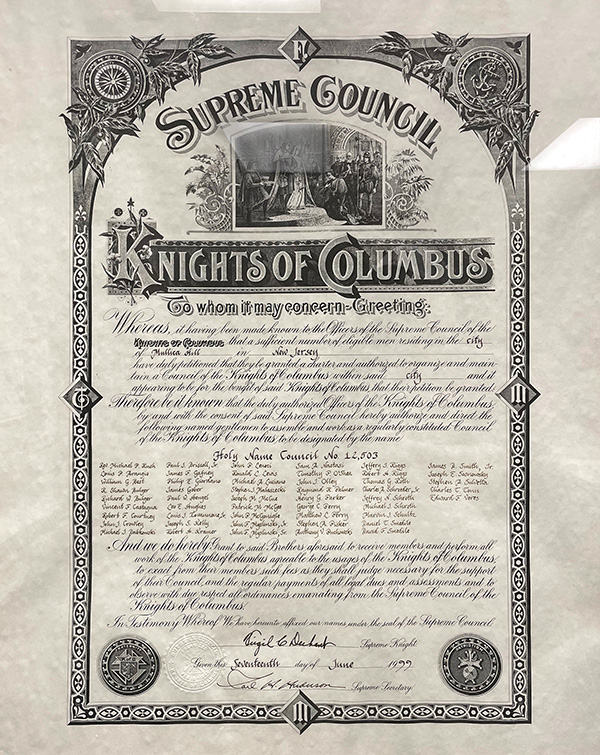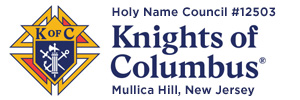The Knights of Columbus was founded by an Irish-American Catholic priest, The Venerable Father Michael J. McGivney in New Haven, Connecticut. He gathered a group of men from St. Mary’s parish for an organizational meeting on October 2, 1881 and the Order was incorporated under the laws of the U.S. state of Connecticut on March 29, 1882. Though the first councils were all in that state, the Order spread throughout New England and the United States in subsequent years.
The primary motivation for the Order was to be a mutual benefit society. As a parish priest in an immigrant community, McGivney saw what could happen to a family when the breadwinner died, and wanted to provide insurance to care for the widows and orphans left behind. He had to temporarily leave his seminary studies to care for his family when his father died. In the late 19th century, Catholics were regularly excluded from labor unions and other organizations that provided social services. In addition, Catholics were either barred from many of the popular fraternal organizations, or, as in the case of Freemasonry, forbidden from joining by the Catholic Church itself. McGivney wished to provide them an alternative. He also believed that Catholicism and fraternalism were not incompatible and wished to found a society that would encourage men to be proud of their American-Catholic heritage.
McGivney traveled to Boston to examine the Massachusetts Catholic Order of Foresters and to Brooklyn to learn about the recently established Catholic Benevolent League, both of which offered insurance benefits. He found the latter to be lacking the excitement he thought was needed if his organization were to compete with the secret societies of the day. He expressed an interest in establishing a New Haven Court of the Foresters, but the charter of Massachusetts Foresters prevented them from operating outside their Commonwealth. The committee of St. Mary’s parishioners which McGivney had assembled then decided to form a club that was entirely original.
McGivney had originally conceived of the name “Sons of Columbus”, but James T. Mullen, who would become the first Supreme Knight, successfully suggested that “Knights of Columbus” would better capture the ritualistic nature of the new organization. The Order was founded 10 years before the 400th anniversary of Columbus’ arrival in the New World, and in a time of renewed interest in him. Columbus was a hero to many American Catholics, and the naming him as patron was partly an attempt to bridge the division between the Irish-Catholic founders of the Order and Catholic immigrants of other nationalities living in Connecticut.
Christopher Columbus is the patron and namesake of the Knights. The Connecticut Catholic ran an editorial in 1878 that illustrated the esteem in which American Catholics held Columbus. “As American Catholics we do not know of anyone who more deserves our grateful remembrance than the great and noble man – the pious, zealous, faithful Catholic, the enterprising navigator, and the large-hearted and generous sailor: Christopher Columbus.”
The name of Columbus was also partially intended as a mild rebuke to Anglo-Saxon Protestant leaders, who upheld the explorer (a Catholic Genovese Italian working for Catholic Spain) as an American hero, yet simultaneously sought to marginalize recent Catholic immigrants. In taking Columbus as their patron, they were sending the message that not only could Catholics be full members of American society, but were, in fact, instrumental in its foundation.
By the time of the first annual convention in 1884, the Order was prospering. In the five councils throughout Connecticut there were 459 members. Groups from other states were requesting information. The Charter of 1899 included four statements of purpose, including “to promote such social and intellectual intercourse among its members as shall be desirable and proper, and by such lawful means as to them shall seem best.” The new charter showed members’ desire to grow the organization beyond a simple mutual benefit insurance society.
The original insurance system devised by McGivney gave a deceased Knight’s widow a $1,000 death benefit. Each member was assessed $1 upon a death, and when the number of Knights grew beyond 1,000 the assessment decreased according to the rate of increase. Each member, regardless of age, was assessed equally. As a result, younger, healthier members could expect to pay more over the course of their lifetimes than those men who joined when they were older. There was also a Sick Benefit Deposit for members who fell ill and could not work. Each sick Knight was entitled to draw up to $5 a week for 13 weeks (roughly equivalent to $125.75 in 2009 dollars). If he remained sick after that, the council to which he belonged regulated the sum of money given to him.
Around 1912 it was claimed that fourth degree Knights had to swear an oath to exterminate Freemasons and Protestants. Despite the fact that it was denied, and the real oath published, this was read into the congressional record by Thomas S. Butler. In the 1928 Presidential election a million copies were printed to hurt the campaign of the Catholic Democratic candidate Al Smith.
Today there are more than 15,000 councils around the world, and the Knights of Columbus is a multi-billion-dollar non-profit charitable organization. Knights distribute Tootsie Rolls to raise funds to fight developmental disabilities, volunteer for the Special Olympics and other charitable organizations, erect pro-life billboards and “Keep Christ in Christmas” signs, conduct blood drives and raise funds for disaster victims, and parade at patriotic events with their red capes, feathered chapeaux, and ceremonial swords.
In 2010, the cause for McGivney’s canonization was before the Congregation for the Causes of Saints. A guild had been formed to promote his cause. On March 15, 2008, Pope Benedict XVI approved a decree recognizing the heroic virtue of Father Michael J. McGivney, founder of the Knights of Columbus. The pope’s declaration significantly advances the priest’s process toward sainthood, and gives the parish priest the distinction of “Venerable Servant of God.” If the cause is successful, he will be the first priest born in the United States to be canonized as a Saint.

Our Council’s History
In 1998, a group of men who were members of a nearby Knights of Columbus Council at Incarnation Parish in Mantua, New Jersey were interested in starting a new council that would support Holy Name of Jesus Parish in Mullica Hill. Seeing that there was a need for the Fraternal Organization’s presence in this quickly growing Parish in Harrison Township, Father Michael P. Rush, the Pastor, approved the concept and allowed the proposed council to be headquartered in the recently built Parish Center.
The Holy Name Council #12503 was awarded its charter on June 17, 1999 by Supreme Knight Virgil Dechant, with C. Thomas Tonn elected the Council’s first Grand Knight, and Father Rush appointed as the Council’s first Chaplain. 50 men were listed on the charter as inaugural members. Four of those charter members went on to become Grand Knights, Dan Smedile, John McGonigle, Jack Olley, and Paul Driscoll. The Parish Deacon, Sam Nastasi, was also a member in that charter class.
Over the next 25 years, Holy Name Council #12503 has raised hundreds of thousands of dollars to support people with intellectual disabilities, damage and displacement caused by storms and tornadoes, helped countless families in need, and supported Catholic Education at all levels.
